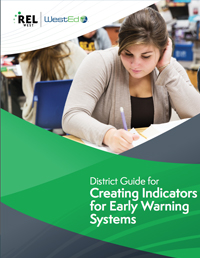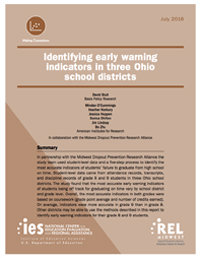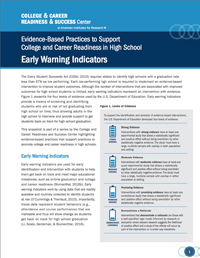What indicators accurately predict which students are on track to graduate college and career ready or need additional supports? For early warning systems to be effective, identifying and selecting appropriate, locally-based indicators is important to accurately predict which students are on track.
 District Guide for Creating Indicators for Early Warning Systems
District Guide for Creating Indicators for Early Warning Systems
Districts and schools that seek to use an early warning system are often left to determine which indicators to use and to trust that fit their local context. This step-by-step guide helps school districts identify and select their own early warning indicators. Included in the guide is a set of templates to document decisions and organize the analysis to identify and select appropriate early warning indicators for your school or district.
 Identifying Early Warning Indicators in Three Ohio School Districts
Identifying Early Warning Indicators in Three Ohio School Districts
What are the critical indicators to help identify students at-risk for failing to graduate on time? This report analyzes early warning indicators in three Ohio school districts. Analyzing attendance, behavioral incidents, and course performance for two cohorts of students in 8th and 9th grades, the report found that different indicators previously identified in the research and different thresholds were the most accurate predictors of students’ failure to graduate on time in the three districts. The report concludes that attendance was shown to be predictive in all three districts and that predictors were more accurate in the 9th grade. School districts interested in using early warning indicators to identify students would benefit from local validation to improve the accuracy of identification.
 Evidence-Based Practices Supporting College and Career Readiness in High School: Early Warning Indicators
Evidence-Based Practices Supporting College and Career Readiness in High School: Early Warning Indicators
Statewide longitudinal data systems (SLDS) offer states a potentially powerful tool to observe trends, assess needs, and develop and refine policies that can promote college and career readiness initiatives aligned with the requirements of the Every Student Succeeds Act (ESSA). In this Ask the CCRS Center brief, we discuss strategies for leveraging SLDS to promote state-defined college and career readiness goals. We highlight state policy examples using SLDS to support college and career readiness from Florida, Georgia, Massachusetts, and Montana.
